Japan
Wood Products Prices
Dollar Exchange Rates of 25th
Jul
2022
Japan Yen 136.7
Reports From Japan
7th covid wave rewriting
infection records
Health authorities across Japan are reporting record high
cases of coronavirus with each day bringing a new record.
The daily count hit a new high in 17 of Japan's 47
prefectures in mid July. The number of COVID-19
patients recuperating at home across Japan reached a
record high of 612,023 on 20 July, double that from a
week earlier. Infections continue to spread due to the
highly contagious BA.5 sub-variant.
Lower economic growth forecast 每 Buiness sentiment
dips
Uncertainty over the direction of the global economy,
blamed on Russia*s invasion of Ukraine and China*s strict
Covid-19 lockdown, has prompted the Japanese
government to lower its economic growth forecast for
fiscal 2022 to about 2%. This was based on forecasts from
the Bank of Japan (BoJ) that lowered growth expectations
because of weakness in private consumption.
See
https://www.businesstimes.com.sg/governmenteconomy/japan-to-cut-this-fiscal-years-economic-growthforecast-nikkei
Ultra-low rate policy maintained
The BoJ has maintained its ultra-low rate policy to support
economic recovery. This is in contrast to the trend of
monetary tightening as other countries report record
inflation.
In its Quarterly Outlook Report after its July meeting the
BoJ raised its core consumer inflation forecast to 2.3% for
fiscal 2022, up from its earlier 1.9%. This takes account of
the surging energy and raw materials costs as well as the
effect of a weak yen which pushes up import costs.
See:
https://mainichi.jp/english/articles/20220721/p2g/00m/0bu/030000c
In related news, the BoJ raised inflation forecast but
maintained its ultra-low interest rate policy saying the
economy is still fragile. This came at around the same time
the European Central Bank signaled an increase in interest
rates to tackle soaring inflation. Rising fuel and
commodity costs have lifted inflation in Japan above its
2% target but the BoJ is no rush to withdraw stimulus
saying in its quarterly report ※We must be vigilant to
financial and currency market moves, as well as their
impact on the economy and prices.§
See:
https://www.boj.or.jp/en/mopo/outlook/gor2207b.pdf
Weak yen improving Japan*s competitive advantage
even against China based companies
The yen/dollar exchange rate has jumped from 103 to 135
in less than two years and the July US interest rate hike
will drive the yen even lower.
The exchange rate of the yen against the Chinese renminbi
is creating a situation in which Japanese corporations are
becoming increasingly price competitive even against
companies based in China.
See:
https://www.etftrends.com/model-portfolio-channel/japansyen-weakness-has-changed-the-competitive-landscape/

Willingness to buy durable goods at all time
low
Households in Japan contine to feel the pressure of rising
prices and this, along with the surging rate of covid
infections across the country has caused confidence to
collapse. The index for willingness to buy durable goods,
such as furniture, in June was at an all time low.
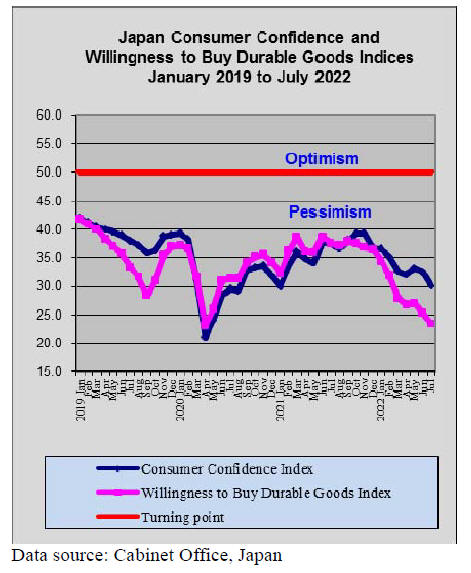
Timber prices soaring 每 another &wood shock*
Prices for plywood and sawnwood have risen 10 to 20% in
the last three months and this is feeding into the price of
new homes. Sawn softwood for construction is in short
supply and some in the industry are calling this another
&wood shock*.
The first wood shock was in the early 1990s, the second in
2000 when logging was restricted in Indonesia. The third
is considered to be last year*s sawnwood price surge, the
result of a rapid recovery in US housing demand.
According to the BoJ*s corporate goods price index wood
product prices rose over 40% year on year in June.
In the face of the rising timber prices there are moves to
raise house prices in Japan. In January, Daito Trust
Construction raised the price of its homes by 2%. A
spokesperson from Sumitomo Forestry is quoted as saying
※this is a difficult situation and we are reviewing home
prices as necessary.§
Attention has turned to domestic timber resources.
Currently, planted forests account for 40% of the country*s
total forests but, according to the Forestry Agency, there is
no efficient supply chain in place for the processing and
distribution of large volumes of domestic wood.
Small and micro-forestry operators account for 90% of the
domestic harvesting and processing industry in Japan and
the number of workers in the sector continues to decline.
The distribution issues need to be addressed in order for
greater use of domestic timber.
See:
https://asianews.network/japanese-lumber-prices-soaringagain/
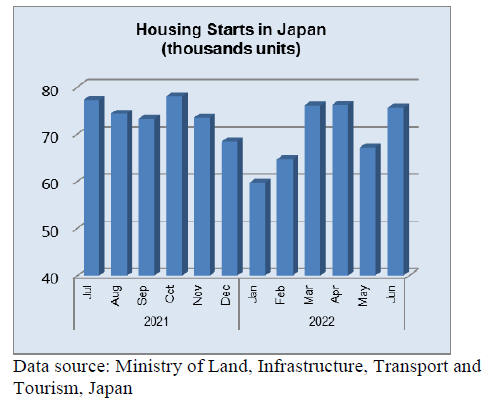
June housing starts were up around 12% compared to
May. The dip in starts in May was because of the long
May holidays. June 2022 stsrts were little changed from
June 2021.
Import update
Assembled wooden flooring imports
For three months since the beginning of the year the value
in yen of Japan*s imports of assembled wooden flooring
(HS441871-79) was declining. The decline ended in May
when the value of imports shot up, almost doubling. Part
of the explanation for this is that the yen has steadily
weakened against the dollar and the Chinese yuan.
China is a major shipper of assembled flooring to Japan.
However, the exchange rate is only part of the answer, it
seems that in May importers anticipated further yen
weakness and stocked up early.
Year on year, assembled wooden flooring imports in May
2022 were up around 90% and month on month the value
of imports rose 80%.
The main category of assembled flooring imported by
Japan continues to be HS441875 and this accounted for
60% of May 2022 imports with the main suppliers being
China and Vietnam.
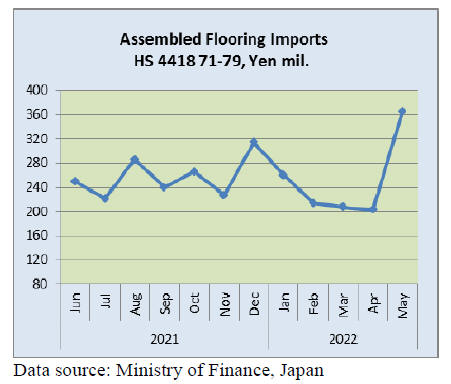
Plywood imports
The main news in April was the doubling of plywood
imports from China. At 25,000 cu.m April shipments were
at a level not seen since 2014/15 and in May the volume of
plywood shipments from China increased further. Year on
year the volume of May plywood imports from China rose
by a factor of 3 to 32,200 cu.m and month on month
imports from China jumped by almost 30%.
Malaysia and Indonesia remain the main plywood shippers
to Japan but in May this year shipments from both
suppliers declined. Of the various categories of plywood
imported in May 2022 (as in other months) HS441231 was
the most common accounting for almost 90% of total
plywood import volumes.
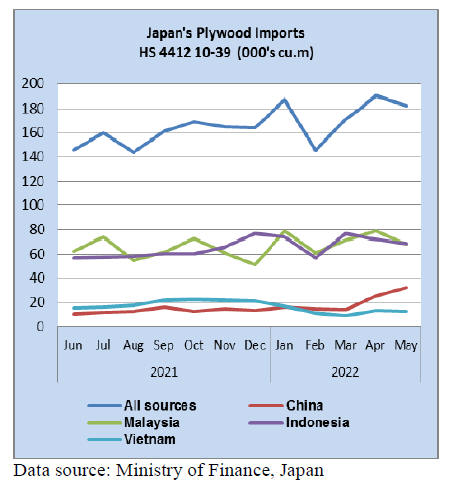
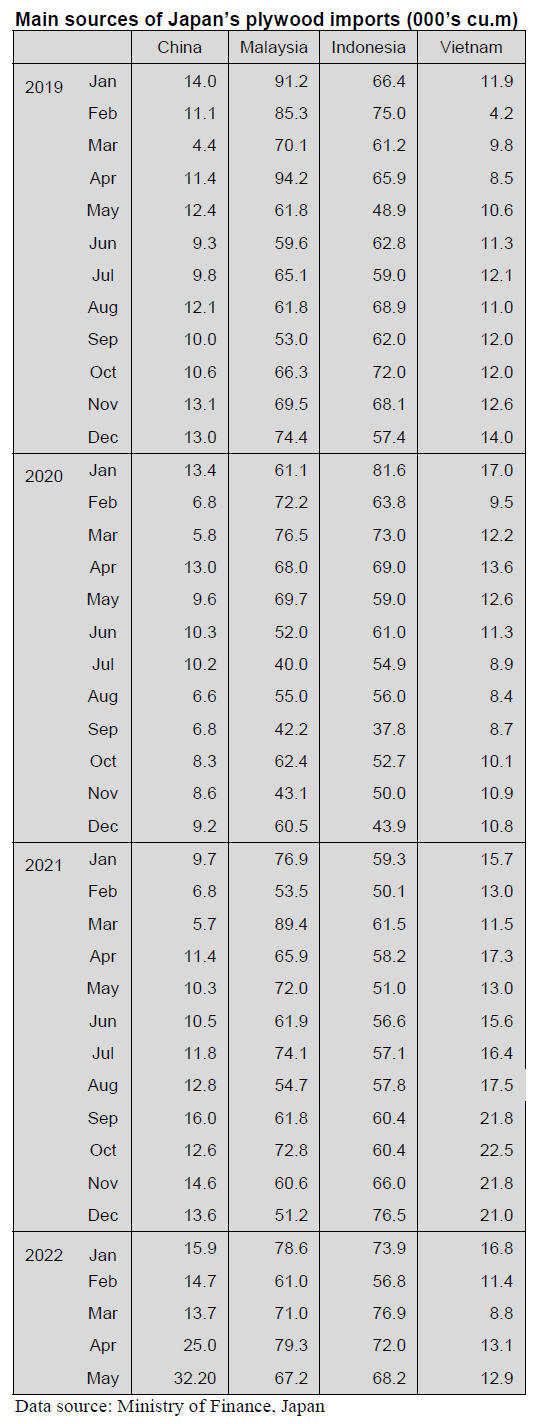
Trade news from the Japan Lumber Reports (JLR)
The Japan Lumber Reports (JLR), a subscription trade
journal published every two weeks in English, is
generously allowing the ITTO Tropical Timber Market
Report to reproduce news on the Japanese market
precisely as it appears in the JLR.
For the JLR report please see:
https://jfpj.jp/japan_lumber_reports/
Imported lumber inventory at Tokyo
Imported lumber inventory at Tokyo at the end of June is
192,000 cbms, 8.5% more than May. It is the highest
volume in this year and it is 2.1 times of May, 2021.
Shipment volume is 67,000 cbms, same volume in
previous month and receiving volume is 83,000 cbms,
36.1% more than previous month. The received volume is
16,000 cbms more than shipment.
New contracts and demand are decreasing so it would take
time for balancing the inventory. The inventory of North
American lumber is 54,000 cbms, 8% increased from last
month. European lumber is 59,000 cbms, 3.5% increased
from last month. Russian lumber is 41,000 cbms, 24.2%
increased from last month. Chinese and other lumber are
30,000 cbms, 3.4% more than previous month.
Wooden boards are 9,000 cbms and it is same volume in
May. Compare to June, 2021, the inventory of North
American lumber doubled in volume.
European lumber is 2.6 times more. Russian lumber is 2.3
times more. North American and European lumber are 1.6
times from the volume of June, 2020.
Receiving volume of North American lumber in June is
21,000 cbms, 90.9% more than May. European lumber is
21,000 cbms, 16.7% more than previous month. Russian
lumber is 22,000 cbms, 100% more than previous month.
One of reasons is that the North American lumber, which
was supposed to arrive in Japan in July, arrived in June by
two bulk ships. It was 13,000 cbms.
The other reason is that a large amount of Russian lumber,
which were contracted in the past, arrived in Japan. Since
the lockdown in China is lifted, a lot of European lumber
piled up in China arrived in Japan. The receiving volume
in July will be 14,000 cbms, 33.3% less than June. Russian
lumber will be 13,000 cbms, 40.9% less than June.
European lumber will be 16,000 cbms, 23.8% less than
June.
Receiving volume of North American lumber in January
to June, 2022 is 112,000 cbms, 13.1% more than same
periods of 2021 and shipment volume is 116,000 cbms,
24.7% more than same periods in 2021. The shipment
exceeded 3.6% of receiving. The inventory decreased
2,000 cbms from December, 2021.
European lumber in January to June, 2022 is 132,000
cbms, 46.7% increased from same periods in last year and
shipment volume is 119,000 cbms, 40% more than same
periods in 2021.
The inventory is 14,000 cbms more than December, 2021.
Russian lumber in January to June, 2021 is 98,000 cbms,
14% more than same periods in 2021 and shipment
volume is 85,000 cbms, 16.4% more than same periods in
2021.
Receiving is 15.3% more than shipment. The inventory is
13,000 cbms more than December, 2021. Total receiving
volume in July will be 59,000 cbms, 28.9% less than June.
The inventory at the end of July will be 187,000 cbms.
However, the inventory might be 190,000 cbms if the
shipment volume would be 2,000 cbms.
Forestry Agency changes hiring policy
The Forestry Agency starts accepting female and foreign
workers for forestry work. It plans to secure more workers
for replantation and nurturing young trees. Number of
forestry business ompany continues declining and majority
is small, petty companies.
Harvest has been increasing but only 30% of logged off
areas are replanted with workers of replanting and
nurturing have been steeply decreasing and it is urgent
matter to secure such workers. Presupposition is to provide
working condition and safety other industries are
providing and to improve stability of workers, it should
offer weekly holidays, monthly salary, providing social
insurance and give fair evaluation to ability.
Stability of newly hired workers after seven years is less
than 50% and labor hazard is more than ten times of other
industries so establishing safety measure is also urgent
matter. Main points are to hire female, aged and
handicapped workers plus to hire foreign workers.
Now in technical learning, foreign workers are allowed to
work only one year but in other industries like farming and
fishing. Foreign workers are allowed for three years so the
Forestry Agency is trying to change the system.
Domestic logs
Demand and supply of domestic logs are not lively. The
prices are still high but not as high as last year.Cypress
logs cost 40,000 每 50,000 yen delivered per cbm in last
year but they are now under 30,000 yen delivered per cbm.
Cedar logs cost 30,000 yen delivered per cbm in last year
and they are under 20,000 yen delivered per cbm in this
year. It was a very short rainy season in this year so there
are enough logs.
On the other hand, a movement of domestic lumber was
slow in June so demand for logs is not so active. 3 meter
cypress logs for posts are around 25,000 yen delivered per
cbm and 4 meter cypress logs for sill are around 24,000
yen delivered per cbm. The lowest price is under 20,000
yen in some areas.
3 meter cedar logs for posts are 16,000 每 17,000 yen
delivered per cbm in main producing districts. There are
20,000 yen in other areas.
Requests for cedar logs are stronger than 3 m
cypress logs.
3.65 每 4 m cedar logs are not really in demand and the
prices are 13,000 每 14,000 yen delivered per cbm.
There is no hope for the prices decreasing like before the
wood shock because some plywood companies could not
buy Russian veneers. However, logging companies are
ready to continue harvesting the trees so the future prices
are unpredictable.
Chinese softwood plywood
The volume of Chinese softwood plywood has been
increasing. It was 19,000 cbms in May and it was 60.3%
more than April. This was because of a shortage of
domestic plywood. However, a shortage of domestic
plywood is now solved slightly and there are less orders
for Chinese softwood plywood recently.
One of reasons is the quality of Chinese softwood
plywood. Sometimes there are uneven thickness or holes
on plywood. Since Japanese companies do not order new
plywood, Chinese companies started cutting the prices. It
was 2,300 yen delivered per sheet at the peak and now it is
1,950 yen delivered per sheet. The price of domestic
softwood plywood for 12mm thickness 3 x 6 is stable at
2,000 yen.
South Sea lumber
Lumber demand for steel and shipbuilding is active but
there is not enough imported lumber so inquiries on
domestic made lumber is active.
Market prices of laminated free board continue climbing.
Export prices of Indonesian mercusii pine lumber are
US$950 per CBM C&F and Chinese red pine lumber are
US$1,020-1,050 per cbm C&F, both are unchanged from
June but the market prices in Japan are being pushed up
with weak yen so mercusii pine lumber prices are 138,000
yen per cbm FOB truck and Chinese red pine lumber
prices are 143,000 yen, both are 5,000 yen up.
Mercusii pine log supply in Indonesia is steady and lumber
production is active particularly high grade but Japanese
demand concentrates in lower grade products. products
only so new purchase is going slow.
|